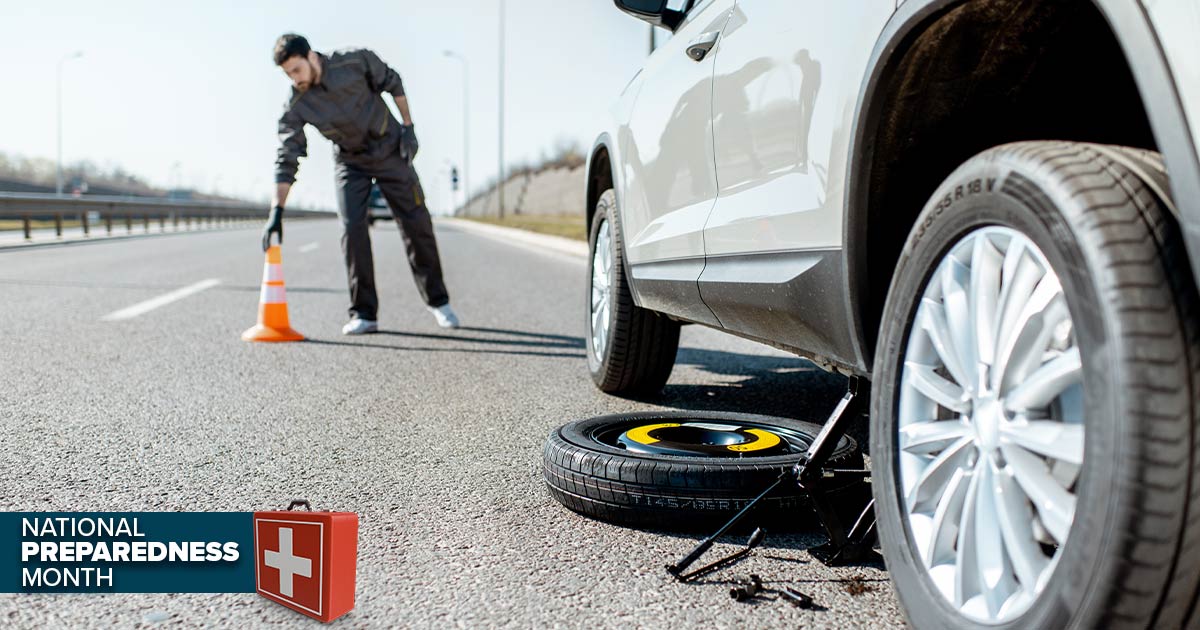National Preparedness Month: How to make sure your vehicle is ready for any emergency

Did you know that the average American spends over 8 ½ hours a week in their vehicle? When it comes to emergency preparedness, we often focus on disasters that happen while we are at home, but many overlook the possibility of a disaster striking while we are away.
Since we spend so much time away from home, it’s a good idea to make sure our vehicle is prepped and ready to face the possibility of a disaster. From wildfires and inclement weather to earthquakes and other emergencies that can happen in Southern California, we need to be ready to respond when disaster strikes.
Setting up an emergency kit: The essential items you need to Survive
There are plenty of ready-made kits on the market; unfortunately, they often don’t include the things we need to survive a disaster here in Southern California. While having a pre-packaged kit is better than nothing, to truly be prepared, you need to either build your own, or modify your store-bought kit to suit the unique needs of your family.
Your basic car kit should include:
- Water: Water is one of the most crucial items to keep in your kit. While you can survive for a few weeks without food, you could perish in a matter of days without water.
- Food: Non-perishable foods like granola, nuts, and tinned meats are all good items to keep in your vehicle. They are easy to store and can help you maintain your strength during an emergency where you become trapped in your vehicle or need to quickly evacuate from your home.
- First aid kit: A good first aid kit is essential and can help with minor injuries or help sustain you until emergency services arrive. Make sure to include things like adhesive bandages, gauze, sunscreen, tweezers, alcohol wipes, medical tape, and anything specific your family’s medical needs.
- Basic tool kit: A good tool kit will have equipment for basic repairs. You should stock things like pliers, wire cutters, electrical tape, screwdrivers, multi-size nut drivers, extra terminals and fuses, and work gloves.
Some other items to consider keeping in your car:
- Jumper cables - Used to restart a dead battery.
- Reflectors And Road Flares- Used to protect yourself in the case of a breakdown, or signal rescuers for help.
- Tire changing equipment – This includes a spare tire, a jack, and a four-way tire iron/ lug wrench.
- Fire extinguisher - If a fire breaks out in your vehicle, you need to quickly assess whether or not it’s safe to try and put it out. Some fires can be contained relatively quickly with a fire extinguisher; others require you to get as far away from the vehicle as possible.
- Tire pressure gauge
- Coolant
- Blanket
- Spare clothes
- Flashlight
- Spare batteries
- Window wash fluid
Staying disaster-ready: Some general rules to follow
Having an emergency kit is an essential part of being prepared, but there are some other things you need to do to make sure you are ready to face disasters and emergency situations while out on the road.
Here are some of the basic rules of keeping a disaster-ready vehicle:
Regular Maintenance
Those who are truly prepared know that regular maintenance on your vehicle is the best way to keep yourself safe when disaster strikes. Before leaving the house in the morning, take a couple of seconds and make sure your vehicle is in good working order. Walk around and check your tires, the visibility through your windows, and make sure nothing looks out of sort.
At least once a month, you should check your vehicle’s oil, transmission fluid, tire pressure, and other fluids. If your vehicle shows any warning lights on the display, has cracks in the window, or shows any signs of electrical problems, you should address those issues immediately.
The last step is to always have at least a half a tank of gas. If a disaster strikes that causes you to have to evacuate your immediate area, the last place you want to end up is in an hour-long line at your local gas station.
Keep your emergency kit stocked and maintained
Having a survival kit is great, but you need to do periodic maintenance checks on it, as well as your vehicle. Take a quick peek in at your kit once a month to make sure everything is still intact and ready to go. Keep in mind, things like batteries go bad after a while, and your food and water should be swapped out every couple of months.
Keep an emergency communication kit
When you are facing a disaster, you need to have multiple ways of contacting your loved ones, as well as hearing emergency broadcast information. A good communication kit will include things like:
- An extra cellphone charger and battery pack.
- A NOAA weather radio.
- Satellite phone or emergency radio.
Also, make sure you take the time to read your equipment manuals and understand the functionality of all your devices before you need them.
Learn to navigate without Google
During an extreme emergency, you may not be able to rely on GPS or the typical routes you travel. Make sure you keep an old school paper map and make sure you have a couple evacuation routes planned out before disaster strikes.
Think of special considerations that may be unique to you and your family
- Do you have pets?
- Do you have elderly parents or care for someone with a disability?
- Do you have medications or things you need to take on a daily basis?
These are all special circumstances that you need to think about before disaster strikes. Remember to build your kits and your emergency plans around your unique circumstances.
Looking for more ways to keep your family prepared?
Keeping your vehicle prepared is one way to ensure you’re ready for an emergency, but one of the best things you can do is make sure you are financially prepared.
When it comes to handling unexpected situations—whether that’s a disaster, a family emergency, or even a car problem—you’re going to need something to fall back on. By building your savings, you ensure your own security in the event of a bad situation, and simultaneously get closer to financial freedom. To learn more about savings and financial freedom, check out the rest of our blog here.




